designpicture booksmovieprocess
previous1234
6. Making prototypes: Interactive toys composed of simple devices
In order to realize the idea of hospital preparations toys with which children feel like to play that I considered at Beatrix Children’s Hospital, I started making simple prototypes. Then, I remembered a trial to express some particular situations or characteristic movements with a simple mechanism, that I used to do in school before, and I thought it would be possible to combine this kind of interactivity to the toys in the same way. The trial was the way to express characteristic behaviors of animals or insects figuratively by combining a simple movement with some kind of shapes without using any high-tech mechanism or devices. So, it gives a surprise as we feel when we touch classical gimmick toys.
I deformed shape of examination machines and made characters with paper and styrene foam and tried to find their right shapes by combining them with LED lights, electric motors and small buzzers. At the same time, I sought for the expression that could characterize each medical examination. I also decided to make picture books that show medical machines as characters. These picture books were intended for using as introduction before children start to play with the toys. I made very simple stories written in a few lines, for example, ‘I am X-ray. I take a picture of your body’.)
In regard to the material, I chose wood that I am familiar with. If I used wood, I could make the thing from the beginning to the end by my hands at the workshop of my school. Besides, as selection of wood, I took maple wood which is easy to handle and possesses appropriate strength.
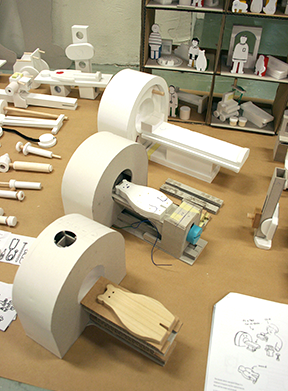
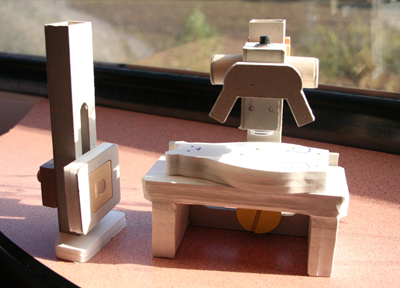
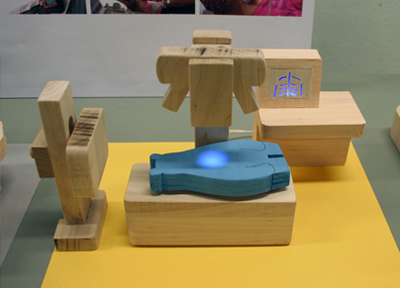
7. Reaction from children: Children started talking about their experiences of diagnoses by using my play preparation toy.
I asked for advice to the hospital play specialists at Beatrix Children’s Hospital on my prototype, and then I finished a working trial model of the toy. In order to see how children react to my play preparation toys, I showed them to children aged 2 to 6 years old, the original target of this project. A girl of 4 year old whom I showed my toys at first took an interest in them, and picked up a doll and started doll-play with it. She seemed to think the part of machines of my toy as something like play equipment in park or robot at first, but she understood that these toys represented things in hospital when her mother explained about the meaning of them with my picture books.
After that, my request to test with actual child patients was kindly accepted by the hospital, and I had an opportunity to see how children, who was expected or already experienced radiation inspection, would treat my toys. A 6-year-old girl who cooperated in my trial was a girl who had experience of hospitalization several times because of a disease of brain. Still very young, she had ever undergone various kinds of diagnoses such as MRI.
When I entered the room where she was hospitalized, her mother and a social worker were there with her. After I explained about my toys, the mother put the toy on her daughter’s knee so that the daughter could play with them sitting on the bed. When her mother started reading the attached picture books and told to her that the toy is CT examination, she understood it and started playing by laying the dolls on the toy bed. Soon, she noticed every toy would react with light and sound, and so she started touching them to see what happens. Furthermore, she began to explain to us what kind of scene she was playing. For example, she told us that a small doll bear was a doctor who is making an examination with the machine.
When she was playing with a set of CT, she said to her mother ‘I cannot move my body during the test. I cannot stand up either. I have to keep still.’ When she began to play with a set of X-ray, her mother explained ‘According to your part to be inspected, you have to stand up or lie down during the examination.’
The girl was playing repeatedly with saying ‘Shall we take a photograph?’, because she liked to push the button of the toy and listened to the shutter sound. According to the play specialist who was looking at her together, the reason why she played in such a way was that she took X-ray photographs several times and got the impression that normally several pictures are taken in one time of examination. Lastly, the girl requested me to improve the model of X-ray camera set, so that she could adjust the position up and down or sideways in the same way like an actual X-ray machine.
A similar scene was seen for a child who was hospitalized for a disease examination of the brain. He started talking about the diagnoses to his mother while he was playing with my toys. Every night when he goes to bed, he put patches of electroencephalography (brain waves) on his head. Since the patches of my ECG toy set looked like the patches, he used them to explain the brain waves to his mother. He looked rather proud of his experiences. After I saw these reactions from children, I thought my toys for hospital play preparation could be used also to make children more confident by sharing their experiences with their family, besides my first aim to get them to be used to the situation before examinations.
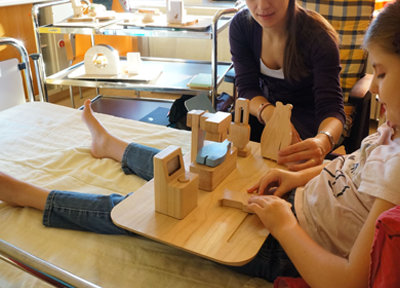

8. The development from now on: Hospital preparation will be practiced easier if more hospitals have hospital preparation toys.
According to the information I got from a Japanese medical equipment manufacturer, about 4000 hospitals out of all 7000 in Japan are equipped with CT machines. In regard to around 90.000 clinics* in the country, most of them have machines such as ECG, Echo and X-ray, and about 10% of them have CT. (*The Medical Care Act of Japan defines a clinic as a medical institution with less than 20 inpatient beds, whereas a hospital with more inpatient beds.) On the other hand, it is said that as the interest in care of children increases in these days, the number of hospital-play specialists has also risen, but yet the number is far from enough to cover all of the children who get medical treatment.
I think if the hospitals which make up for a shortage of hospital play specialist with volunteers, such as Beatrix Children’s Hospital does, and if they can gain appropriate tools, they will be able to practice hospital play preparation more often. The novel hospital toys, the toy set for hospital play preparation, is still at prototype stage and it has many issues such as structure, safety and hygiene control before they are used at actual sites. But in order to respond to the demand of people who contacted me with interests, I’m thinking of realizing it in some way in future.
This project has been realized in cooperation with:
M.van Gent, S.Murray Salander, K.Silfvenius, H.Shima, S. Morisaki, Y.Tanaka, K.Ishiyama, H.Matsuo, T.Miyakawa, H.Shimizu, F.Ito, H. Ching Chuang, Beatrix Kinderziekenhuis of University Medical Center Groningen, The Netherlands and Astrid Lindgren Children's Hospital of Karolinska University Hospital Solna, Sweden
The Novel Hospital Toys was produced by Hikaru Imamura as her graduation work at Design Academy Eindhoven in 2011.
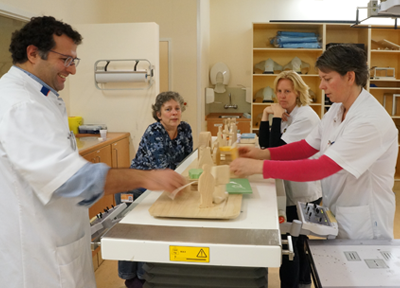
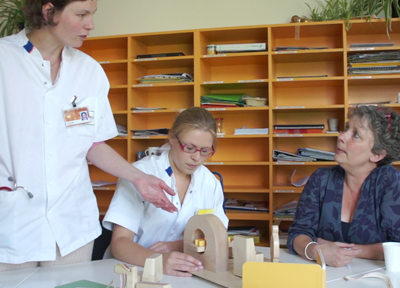
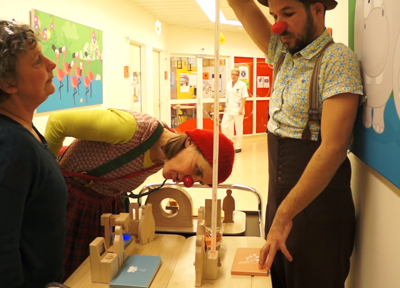
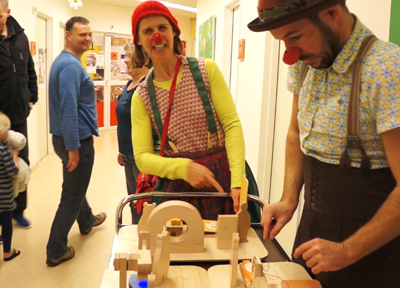
6. 試作づくり
簡単な仕掛けでできるインタラクティブなおもちゃ
ベアトリクス病院で考えた「子供が楽しめるプリパレーションのおもちゃ」を表現するため、簡単な試作を作り始めました。簡単な仕掛けで特徴的な動きやある状況を表現してみるという、以前学校で行っていた試みを思い出し、おもちゃに同じように何らかのインタラクティブな作用を取り入れてはどうかと考えました。その試みとは複雑なメカニズムやハイテクな仕組みなどを用いずに、ある形にある単純な動きを合わせ動物や昆虫の動きを比喩的に表現するというもので、昔のからくりおもちゃを触ったときのような驚きがありました。
紙やフォーム材を使って、おもちゃのキャラクターや機器をデフォルメした形を作り、LEDライトや単純なモーター、小さなブザーなどを組み合わせて、それぞれの検査を特長づける表現を探りながら形を見つけていきました。また、子供がおもちゃで遊び始める前のイントロダクションとして使えるように、それぞれの検査機器をキャラクターに見立てた単純な話の絵本もつくる事にしました。(例えばX線では「私はX線といいます。あなたの身体の中の写真をとります」といったもの)
7.子供たちの反応
おもちゃを通じて子供達が自分の検査の経験を話し始めた。
簡易的に作った模型にベアトリクス病院のプレイスペシャリストの方達の意見をもらい、おもちゃのプロトタイプを完成させました。
このおもちゃに子供達がどんな反応をするのか試すため、ターゲットとする2歳から6歳の子供たちに見せてみました。最初に試した4歳の女の子は、これは何だろうという様子で私のおもちゃに近づき、まず人形を手に取り、人形ごっこのようにして遊び始めました。最初、彼女には機械の部分はロボットか公園の遊具のように見えたようでしたが、その後、彼女の母親が絵本を見せながら少し説明してあげると、病院で起こる事なんだなということが理解できたようでした。
その後、ベアトリクス病院の特別な計らいによって、CTなど放射線検査を受ける(受けたことのある)子供達に私のおもちゃを試用してもらう機会をもらいました。ベアトリクス病院で、最初に私のトライアルに協力してくれた6歳の女の子は、数年前から脳の病気を煩い、これまで幾度か病院へ入院するという経験を持っている子で、MRI等様々な種類の検査を受けた経験をもっていました。
私が女の子の入院している部屋へ入ると、その女の子の隣に彼女の母親とソーシャルワーカーの女性が一緒に付き添っていました。私がおもちゃの説明をすると、女の子の母親は女の子がベッドに座ったままで遊べるように、おもちゃを彼女の膝の上にのせました。母親が付属の絵本を読んで、これはCT検査だと話始めると、彼女もすぐに理解したようで、彼女は人形をおもちゃ検査のベッドに寝かせたりして自分で遊びはじめました。すぐに、ベッドやマシーンを動かすと音や光が反応する仕掛けに気がつき、色々触って試し始めました。さらに、小さいクマを医者に見立て、「自分が医者になって検査をしている所なの」というように、どういう場面を演じているのか話し始めました。
CTのおもちゃを触っている時は「検査中は動いてはいけないの。立つ事も出来ないし、じっとしなくてはいけないの。」と実際の検査中の状況について母親に説明し、X線レントゲンのおもちゃを触った時は、今度は母親が彼女に「レントゲンには立って写真を撮る場合と寝て撮る場合があって、それぞれ撮影する身体の部分によって違うのよ。」と説明していました。
X線のマシーンのボタンは押すたびにシャッターの音が鳴るので、女の子は「写真をとりましょう。」と言って何度も繰り返して遊んでいました。そばにいたプレイスペシャリストの女性が言うには、そのように女の子が何度もスイッチを押すのは、おそらく普段から検査を数回に渡って行われている感覚があるからだろうとのことでした。最後に、レントゲンのカメラについて、本物では撮影位置をセットするためにカメラを下にさげたり左右に回わしたりできるので、おもちゃでもそのように動かしたいとリクエストされました。
おもちゃを触りながら、親に自分の受けた検査について話始めるという場面は、もう一人の脳の検査で入院している男の子にも見られました。その男の子は、毎晩就寝時に脳波検査のパッチをつけて寝ているそうで、そのパッチに少し似ている私のECGのおもちゃを使って母親に脳波の話をしていました。その姿は少し誇らしげであるように見えました。これらの子供たちの反応を見ていると、私のプレイプリパレーション用のおもちゃは、検査の前に遊んで慣れ親しんでおくという目的の他に、検査の後に自分の受けた処置について理解し、その経験を家族に伝える事で自信を得るための助けにもなるのではないかと感じました。
8.今後の展開
プリパレーション用のおもちゃによって、プリパレーションがもっと容易に実践されるようになるのでは?
ある日本の医療機器メーカーから聞いた話によると、日本の場合、国内にある約7000の病院中約4000の病院がCT装置を備えており、国内の約90000軒の診療医院については、大多数がECGやエコー、X線撮影機器を備え、10パーセントがCT機器を備えているそうです。(日本では病床数20床以上の入院施設を備える医療機関を「病院」と称し、それ以下は診療所とされる。)
一方、ホスピタルプレイスペシャリストの数は、医療現場での子供のケアへの関心の高まりもあり、増え続けているそうですが、医療を受ける子供の数を考えるとまだ十分とは言えないようです。
ベアトリクス病院のようにボランティアのサポートで保育士の不足を補っている病院の場合、
せめて現場に適切なツールがあれば、より頻繁にプリパレーションが実践されるようになるのではないかと思います。Novel Hospital Toysはまだプロトタイプの段階であり、構造、安全性や衛生管理など、現場で使えるようにするには解決すべき点が多くありますが、興味を持って問い合わせしてくださった人の声に応えるため、今後 何かの形で実現できたらと思っています。
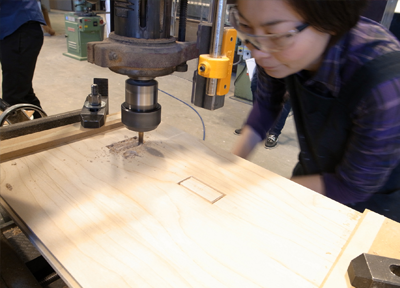
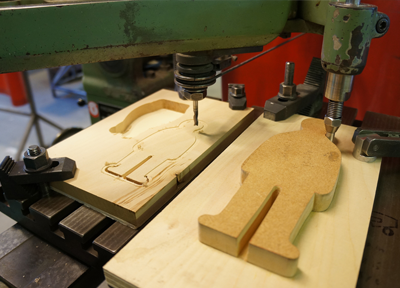
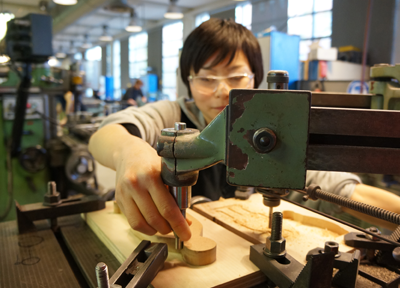
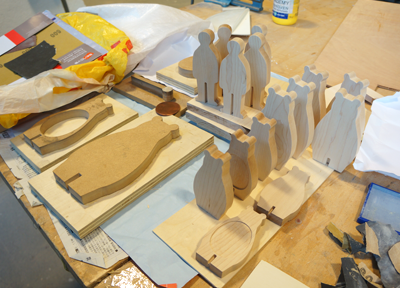
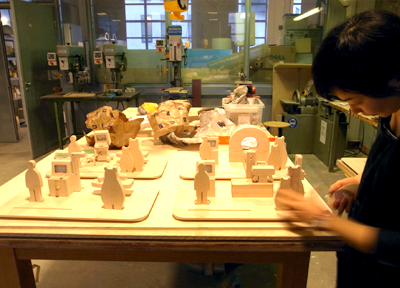
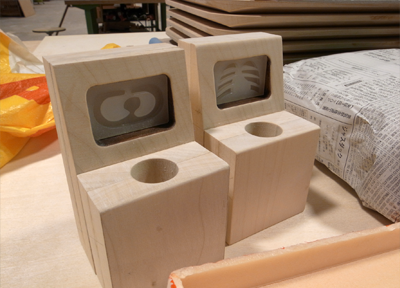
previous
1
2
3
4